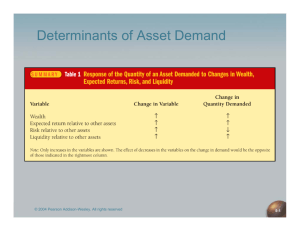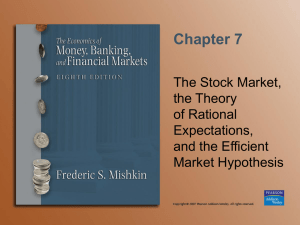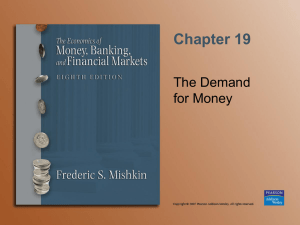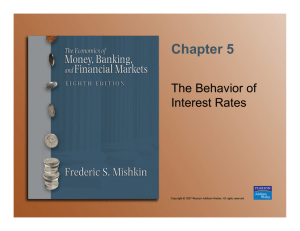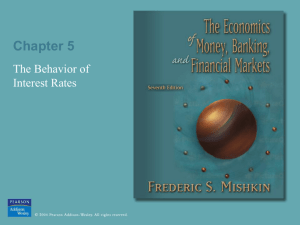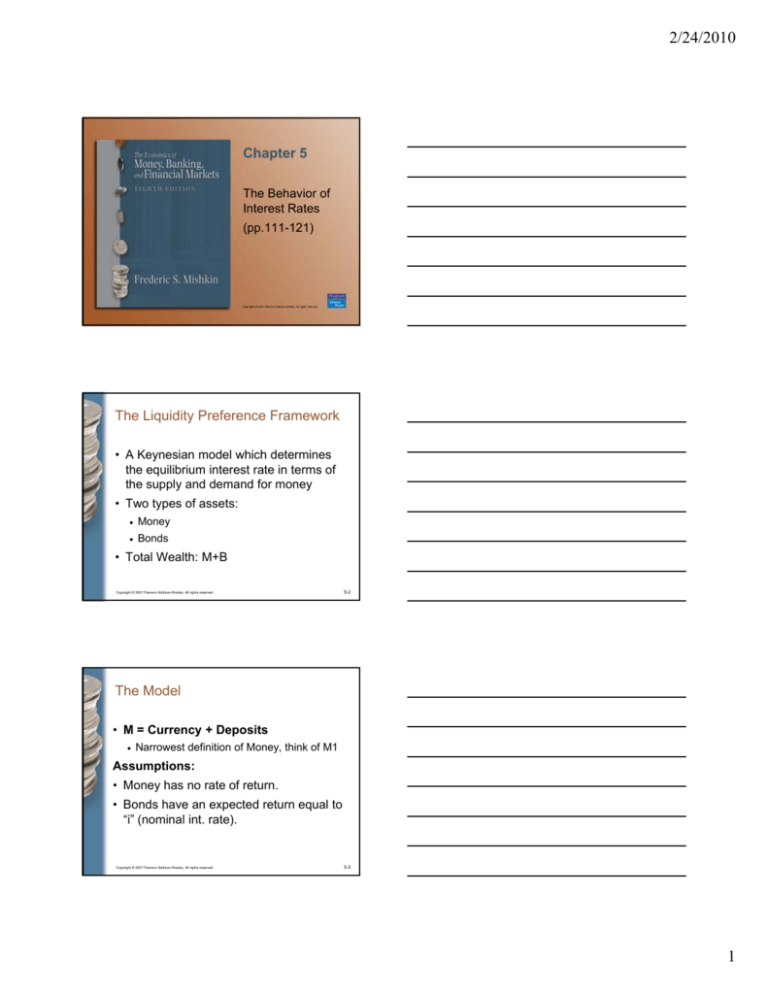
2/24/2010
Chapter 5
The Behavior of
Interest Rates
(pp.111-121)
The Liquidity Preference Framework
• A Keynesian model which determines
the equilibrium interest rate in terms of
the supply and demand for money
• Two types of assets:
Money
Bonds
• Total Wealth: M+B
Copyright © 2007 Pearson Addison-Wesley. All rights reserved.
5-2
The Model
• M = Currency + Deposits
Narrowest definition of Money, think of M1
Assumptions:
p
• Money has no rate of return.
• Bonds have an expected return equal to
“i” (nominal int. rate).
Copyright © 2007 Pearson Addison-Wesley. All rights reserved.
5-3
1
2/24/2010
• As interest rate increases, the expected return on
money relative to bonds decreases
• FACT:
Price of a bond is negatively related to i
i (up),
(up) P (down)
bond
• Æi (up), P (down), D (up), D
bond
bond
money
(down)
• OR: As interest rate increases, opportunity cost of
holding money increases
• Æ Downwards sloping demand curve
5-4
Copyright © 2007 Pearson Addison-Wesley. All rights reserved.
• Assume central bank
inelastically supplied Ms=300
• Equilibrium is stable.
• At point A, Md<Ms : excess
supply of M
M.
Æpeople buy bonds
Dbond (up), Pbond (up), i (down)
• At point E, Md>Ms : excess
demand for M.
Æ people sell bonds.
Dbond (down) , Pbond (down), i
(up)
Copyright © 2007 Pearson Addison-Wesley. All rights reserved.
5-5
Changes in equilibrium interest rates
• Refresh our background:
• When you plot a function such as:
Md = a – b * i
Any change in the independent var. (i.e. i)
causes a movement along the curve
Any other change shifts the demand curve
Copyright © 2007 Pearson Addison-Wesley. All rights reserved.
5-6
2
2/24/2010
Shifts in the Demand for Money
• Income Effect —a higher level of income causes the
demand for money at each interest rate to increase
and the demand curve to shift to the right
Wealth effect (store of value)
T
Transaction
ti effect
ff t
• Price-Level Effect —a rise in the price level causes
the demand for money at each interest rate to
increase and the demand curve to shift to the right
To purchase as many real goods and services
Copyright © 2007 Pearson Addison-Wesley. All rights reserved.
5-7
Shifts in the Supply of Money
• Assume that the supply of money is
controlled by the central bank
pp y
• An increase in the moneyy supply
engineered by the Federal Reserve
will shift the supply curve of money to
the right
Copyright © 2007 Pearson Addison-Wesley. All rights reserved.
5-8
• What are the effects of these shifts in
equilibrium interest rates?
Copyright © 2007 Pearson Addison-Wesley. All rights reserved.
5-9
3
2/24/2010
5-10
Copyright © 2007 Pearson Addison-Wesley. All rights reserved.
• The “Liquidity Effect” : M (up), i (down)
S
Copyright © 2007 Pearson Addison-Wesley. All rights reserved.
5-11
Copyright © 2007 Pearson Addison-Wesley. All rights reserved.
5-12
4
2/24/2010
Everything Else Remaining Equal?
• So far the analysis was conducted in a static
framework, assuming everything else remains
constant.
• Liquidity preference framework leads to the conclusion
that an increase in the money supply will lower interest
rates the liquidity effect: MS (up),
rates—the
(up) i (down)
• However, in a dynamic framework, the liquidity effect
is followed by the following offsetting effects:
Income effect
Price Level effect
Expected inflation effect
5-13
Copyright © 2007 Pearson Addison-Wesley. All rights reserved.
Income Effect
• Recall from econ.202 that expansionary monetary policy
increases income
M (up), i (down) ÆI (up)ÆY (up)Æ M (up)Æi (up)
S
d
After th
Aft
the iinitial
iti l liliquidity
idit effect,
ff t th
the iincome effect
ff t causes iinterest
t
t rates
t
rise because increasing the money supply is an expansionary
influence on the economy.
• Æ What is the net impact on i?
• In the money market: Supply shift followed by a demand shift
5-14
Copyright © 2007 Pearson Addison-Wesley. All rights reserved.
Price Level Effect
• Recall from quantity theory that an increase in the
money supply leads to a an increase in the price level.
• When the price level increases, money demand
increases as well:
M (up), i (down) ÆY (up)Æ P (up)Æ M (up) Æi (up)
S
d
• Æ What is the net impact on i?
Copyright © 2007 Pearson Addison-Wesley. All rights reserved.
5-15
5
2/24/2010
Expected Inflation Effect
• An increase in the money supply may lead people to
expect a higher price level in the future.
MS (up), i (down) Æπe (up)Æ i (up): Fisher
effect: i = ir + πe
Liquidity effect is followed by an upwards movement
in interest rates
• Æ What is the net impact on i?
Copyright © 2007 Pearson Addison-Wesley. All rights reserved.
5-16
Price-Level Effect
vs. Expected-Inflation Effect
• A one time increase in the money supply will cause
prices to rise to a permanently higher level by the
end of the year. The interest rate will rise via the
increased prices.
• Price
Price-level
level effect remains even after prices have
stopped rising.
• A rising price level will raise interest rates because
people will expect inflation to be higher over the
course of the year. When the price level stops rising,
expectations of inflation will return to zero.
• Expected-inflation effect persists only as long as the
price level continues to rise.
Copyright © 2007 Pearson Addison-Wesley. All rights reserved.
5-17
How do these effects interfere with the
liquidity effect ?
• The final outcome of a monetary policy
action on interest rate depends on the
timing and the magnitude of offsetting
shifts
hift in
i the
th economy
Copyright © 2007 Pearson Addison-Wesley. All rights reserved.
5-18
6
2/24/2010
Copyright © 2007 Pearson Addison-Wesley. All rights reserved.
5-19
7




